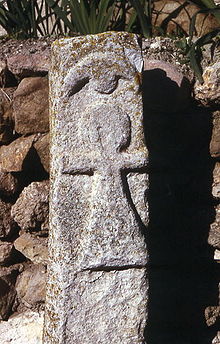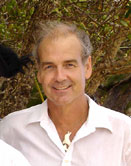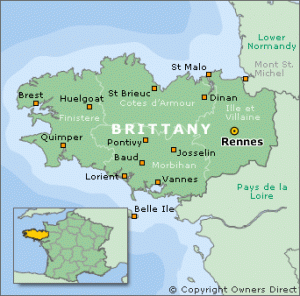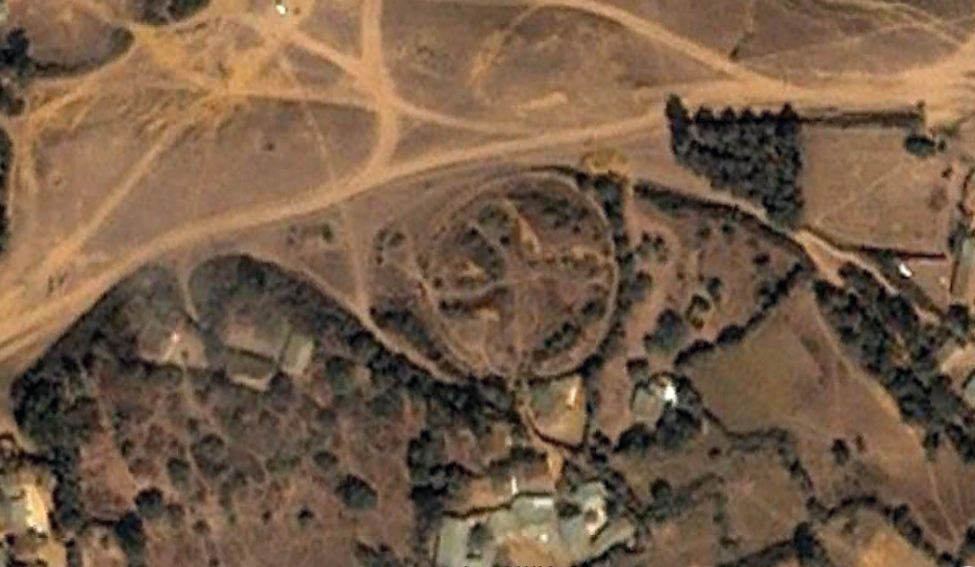Berbers
Tanit
 Tanit was a Carthaginian and Phoenician goddess. Immanuel Velikovsky claimed that the name of modern Tunis, near the site of Carthage, is a cognate of Tanit. She was also adopted by the Berbers and claims have been made that Tanit was also a Hyksos goddess.
Tanit was a Carthaginian and Phoenician goddess. Immanuel Velikovsky claimed that the name of modern Tunis, near the site of Carthage, is a cognate of Tanit. She was also adopted by the Berbers and claims have been made that Tanit was also a Hyksos goddess.
The Egyptian city of Sais where Solon first learned of Atlantis had it principal temple dedicated to the goddess Neith, whom the Egyptian priests identified with Athene. In turn, Neith is also associated with the Libyan goddess Tanit.
The whole matter of the relevance of Saïs to the Atlantis story has been challenged by the theory(a) that Saïs and Tanis, named after Tanit, were in fact the same location. A starting point is the fact that the current village of Sa el Hagar adjacent to the ruins of Saïs has a counterpart at Tanis where there is a village called San el Hagar. Drawing on the writings of Strabo, Herodotus and the Bible some have concluded that the two cities were one. Velikovsky also proposed this idea in his Ramses II and His Time[0832.209], noting that “Tanis is mentioned in Scriptures as the capital of Egypt when. according to both the conventional plan and this reconstruction, Saïs was the capital.”
The island of Es Vedra off the west coast of Ibiza, the third largest of the Balearics, has had a number of imaginative myths, old and new, associated with it, including one that it is supposed to be the birthplace of Tanit!
(a) https://h2g2.com/forums/A148907/conversation/view/F19585/T7572591/page/1/
Idjennaden, Bob (m)
Bob Idjennaden is a Belgian author now living in Ireland, working in the field of business organisation.  His private interests include the study of North African prehistory and history. This has led to the writing of a series of short books, sometimes with co-authors, which deal with specific aspects of North African history and culture.
His private interests include the study of North African prehistory and history. This has led to the writing of a series of short books, sometimes with co-authors, which deal with specific aspects of North African history and culture.
*[An article on the tribes of the Roman province of Africa Proconsularis, centred around modern Tunisia should be read(b) in conjunction with Idjennaden’s work.]*
I am not aware of Idjennaden touching on the subject of Atlantis, in spite of the fact that Plato clearly states that the Atlanteans controlled Libya as far as Egypt. Nevertheless, many of the books deal with specific matters related to different Atlantis theories, such as the Sea Peoples[1195] , the Canary Islands and Berbers.
(a) https://www.amazon.co.uk/Bob-Idjennaden/e/B0079G2BM8
(b) https://melitainsula.blogspot.ie/2010/10/indigenous-tribes-of-africa.html
Marsh, Peter

He takes Plato’s Atlantis account at face value and accepts that it flourished sometime around 9,500 BC. Additionally, in chapter 10 of his website, he refers to the Michigan copper mines and surmises that they were transported to Europe by Phoenicians and Berbers!
>Despite the above Marsh published a paper on the Atlantisforschung website unexpectedly entitled The Golden Age – Atlantis in the Caribbean(c).<
(a) https://web.archive.org/web/20190922053225/https://www.polynesian-prehistory.com/
(b) https://grahamhancock.com/phorum/read.php?1,210178,211208
Borg, John
 John Borg (1873-1945) was a renowned Maltese botanist, who expressed the view, in 1910, that “the tradition of the submerged Atlantis to which many ancient writers refer, and which when deprived of its legendary character will be found to apply to the submerged land between Malta and Africa. This submersion must have happened in the quaternary period, and at an epoch when the land was already inhabited by a civilized prehistoric people of which the Kabyli and Berbers of North Africa are possibly the survivors.” [1132]
John Borg (1873-1945) was a renowned Maltese botanist, who expressed the view, in 1910, that “the tradition of the submerged Atlantis to which many ancient writers refer, and which when deprived of its legendary character will be found to apply to the submerged land between Malta and Africa. This submersion must have happened in the quaternary period, and at an epoch when the land was already inhabited by a civilized prehistoric people of which the Kabyli and Berbers of North Africa are possibly the survivors.” [1132]
Two Crops a Year
Two Crops a year is one of the characteristics of Atlantean agriculture according to Plato (Critias 118e).
The North African climate was slightly wetter at the time of Hannibal (2nd & 3rd cent. BC), later, Algeria, Egypt and particularly Tunisia, were the ‘breadbasket’ of Rome(b) and may also have been so for the Atlanteans who earlier had control from North Africa to Tyrrhenia! Even today well-irrigated plains in Tunisia can produce two crops a year, usually planted with the autumnal rains and harvested in the early spring and again planted in the spring and harvested in late summer. The Berbers of Morocco produce two crops a year—cereals in winter and vegetables in summer(a).
It is worth noting that Mago, the Carthaginian author of a 28-book work on the agricultural practices of North Africa. had his books brought to Rome after the destruction of Carthage in 146 BC, where they were translated from Punic into Latin and Greek and were widely quoted. It is clear that Mago’s work was a reflection of a highly developed agricultural society in that region, a description that could also be applied to Plato’s Atlantis!
Although two crops are possible annually in other parts of the world, I must emphasise that North Africa is the only part of the Atlantean territory referred to by Plato (Timaeus 25b) that was so productive and continued to be so until the Romans, who depended on it along with Egypt to feed Rome.
>James Bailey who advocated an American location for Atlantis refers [150.63] to the irrigation systems of ancient Mexico and the ability to raise three crops a year in Mexico and the coastal plains of Peru as all echoes of Plato’s description of Atlantis.<
Dodson, Frederick
Frederick Dodson is the author of Atlantis and the Garden of Eden[0989] and has published a number of
excerpts from it on his website(a). These deal with, the Basques, Berbers, Etruscans, Minoans and Guanches among other subjects. He also includes a commentary on ancient maps(c).
He has devoted much space in his book and his website to the mystery of very large megaliths, such as at Baalbek and the unfinished obelisk at Aswan(d).
What I read seemed fairly standard fare, but then in a second book[1657], he advanced into ‘ancient astronaut’ territory, at which point I parted company with him.
Even more hilarious is his The Pleiades and Our Secret Destiny[1658] in which he tells the story of his encounters with blue-skinned beings from the Pleiades!
Dodson is also self-promoted as a ‘reality creation’ coach(b). Hmm.
(a) https://www.ancient-atlantis.com/ (offline October 2017)
(b) https://www.realitycreation.org/
(e) https://www.realitycreation.org/ancient-aliens-of-atlantis/
Mzora Stone Circle
The Mzora Stone Circle is a huge megalithic monument in Morocco and is in fact the largest stone ellipse in the world. Mzora and the Egyptian Nabta Playa site are claimed to have used the same construction methods that Alexander Thom has shown to have been used by the British megalith builders. A recent article by Sarah P. Young claims that “The circle is constructed using a Pythagorean right angled triangle with the ratios 12, 35, 37 and this is the same method used by 30 megalithic stone circles in Britain alone. Other similarities in construction and proportions exist such as the use of the so called ‘megalithic yard – a unit of measurement which seems to have been universally employed across Europe – and evidently even further afield” (g).
Although no formal claim has been made for any connection with Atlantis, the supporters of the idea that the megalith builders were Atlanteans see the complexity of the Mzora site as further justification for their opinion. A July 2018 paper(f) links the ancient Berbers with Mzora and as the Berbers occupied territory described by Plato as Atlantean (Timaeus 25a-b & Critias 114c), Mzora may also be legitimately described as Atlantean.
James Mavor, better known for his research at Santorini, surveyed the Mzora site in the 1970s. Bob Quinn visited the site in 1982 and was struck by its similarity with Newgrange! Robert Temple discusses the site at length in his Egyptian Dawn[736].>According to Hugh Newman in a paper on the global ubiquity of stone circles(h), he refers to Mavor’s work and notes that Mzora “appears to have been constructed either by the same culture that erected the megalithic sites in France, Britain and Ireland or by one that was intimately connected with them.”<
John E. Palmer visited and surveyed the site in 1978 and subsequently wrote an article for Kadath magazine, unfortunately in French only. He reported that extensive damage was done to the site by ‘archaeologist’ César Luis de Montalban with excavations in 1935-6(d) and that many of the stones have been broken by ignorant Islamic extremists.
In 2011, Graham Salisbury gave coordinates for the site and offers a history of Mzora in a longer article(b).
(b) See: https://heritageaction.wordpress.com/2011/01/27/the-mysterious-moroccan-megalithic-menhirs-of-mzora/
(d) https://www.stonepages.com/news/archives/004222.html
(g) https://www.ancient-origins.net/ancient-places-africa/mzora-stone-circle-0011778
Bretons *
The Bretons are a cultural grouping located in Brittany in northwest France, where the most outstanding megalithic monuments of Europe are situated. Today, the Bretons consider themselves a separate Celtic  people, with a strong nationalist movement(c).
people, with a strong nationalist movement(c).
It was in 1839 that the Rev. Algernon Herbert (1792-1855), Dean of Merton College, Oxford, was the first to use the term ‘megalithic’ in a paper describing the monuments of England and Brittany.
Since the middle of the 19th century a number of commentators right up to the present have labelled the Bretons as Atlantean. These include R. Cedric Leonard(a), who In support of this idea cites both Stephen Oppenheimer and Herodotus, although he does so some reservations. Hank Harrison wrote Finding Atlantis in which, he supported the idea of a megalithic Atlantis with its centre of power probably located in the Morbihan area of Brittany.
In the 19th century, Ignatius Donnelly quoted Eugene Bodichon as expressing a similar view[021.389]. Bodichon’s opinion is simply based on the temperament and physical similarities between the Bretons and the Berbers of North Africa. Similarly, Gerry Forster refers to Bodichon’s opinion in his The Lost Continent Rediscovered(b). I do not think that the case is proven, even if the legendary kingdom of Ys, reputedly off the Brittany coast, is brought into the debate.
(a) See: https://web.archive.org/web/20170113172907/https://www.atlantisquest.com/Bretons.html
(b) Gerry Forster (archive.org) *
(c) https://ansionnachfionn.com/2011/08/18/at-home-amongst-the-bretons/
Bodichon. Dr. Eugene (L)
Eugene Bodichon (1810-1885) was a French physician and anthropologist who wrote in his 1847 book Études sur l’Algérie[0991] that “the Atlanteans among the ancients, passed for the favourite children of Neptune, they made known the worship of this god to other nations.” This has been interpreted by commentators, such as Robert Stacy-Judd[607.63], as a suggestion that the Atlanteans were the first known navigators.
Ignatius Donnelly quotes Dr. Bodichon as identifying the Atlanteans as the inhabitants of the ‘Barbary States’ or the Berber Coast of North Africa and that in turn the Berbers were related to the Bretons of ancient Armorica, who should also be considered Atlantean.
Capsian Culture (t)
The Capsian Culture was the African counterpart of that of the Azilian people of Europe,*[dating from 8000 to 4500 BC.]* They were among a number of groups included under the umbrella title of Cro-Magnon Man. They were originally centred in the region of the Tunisian and Algerian chotts (blue area on map), spreading later across North Africa and are generally accepted as the ancestors of today’s berbers, frequently suggested to be descendants of the Atlanteans.



